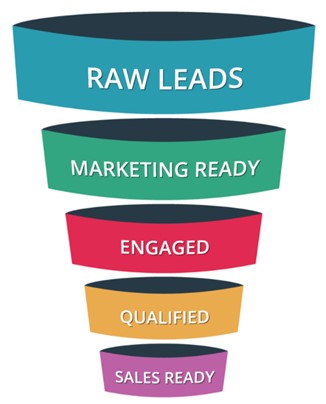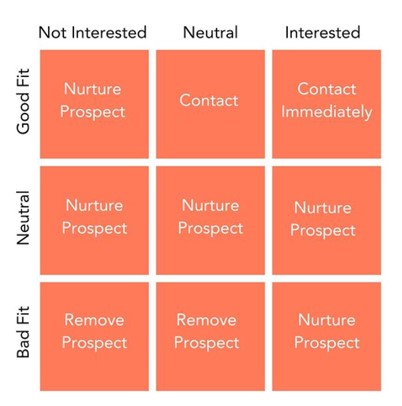Generating leads is vital to acquiring new customers. 74% of companies agree that converting leads into paying customers is their top marketing priority.
Once you have leads, what do you do with them?
Managing leads is similar to passing a baton from one runner to another during a relay race – it requires the right amount of precision and timing to be victorious. Knowing what to do with a lead and when to do it is essential for bringing in new customers.
Every lead is unique. Each contact will have specific characteristics that can help your marketing and sales teams identify when a lead is ready to be nurtured by marketing as a marketing qualified lead (MQL) and by sales as a sales qualified lead (SQL).
The lead (customer) lifecycle
To know when a lead is ready to be handed over to marketing or sales is essential.
Having a solid understanding of the journey that contacts embark on from the moment they first interact with a company until they become customers helps organizations determine what they are doing right and wrong when attracting potential customers.
Each stage of the lead lifecycle reflects certain behaviors and levels of interest that leads often demonstrate to a business.
Handing off leads from the marketing department to sales requires both teams to be on the same page. When a lead is ready to start talking costs and inches closer to becoming a customer, identifying the ideal time to do this should be looked at like a perfectly coordinated dance.
While every lead is unique, categorizing them into a designated customer buyer persona can give your teams a better idea of the right time to determine leads as MQLs and SQLs.
 (Source: Zoho)
(Source: Zoho)
Raw lead
A raw lead is often a brand-new lead who has just provided their email address, often in exchange for access to a content offer on a company website or through the organization’s social media profiles.
In this stage, organizations aim to build awareness about the problems they can address for their customers. They can do this through blogs, email newsletters, and social media.
Marketing ready lead
A raw lead will become a marketing ready lead as soon as they begin to receive marketing campaigns. This can be through social media as retargeting social media ads or a series of marketing-focused emails.
This stage aims to teach people the best way to choose a solution to their problem areas. Marketing often offers eBooks, webinars, and other gated content to pique a lead’s interest.
Marketing engaged lead
Leads who respond to the company’s marketing campaigns are considered marketing engaged leads.
Marketing Qualified Lead (MQL)
Marketing engaged leads responsive to the business’s marketing campaigns and are qualified and considered good potential buyers are labeled as MQLs.
Sales qualified lead (SQL)
As MQLs are referred to the sales department, sales should agree with marketing that the contact has enough interest and is an excellent fit to continue nurturing.
SQLs can become sales opportunities, and customers
Sales qualified leads (SQLs) can become “opportunities” when an account executive agrees that a sales deal may be worth pursuing. For this to happen, the contact must pass a lead scoring assessment to ensure that sales staff invest their time wisely.
As sales opportunity contacts continue learning about and see the value of investing in a company’s product or service, they can eventually become a paying customer.
Why this matters
Knowledge is power.
For this reason, knowing where your prospects lie in the customer lifecycle can help your organization generate more revenue with fewer leads. It is like squeezing every last drop of juice out of a lemon.
By pinpointing who to focus on, your marketing and sales staff can target contacts who demonstrate the highest probability of becoming customers.
Identifying quality leads from those who cannot help marketing and sales filter out who is worth investing in and help them increase their overall productivity.
Distinguishing MQLs and SQLs
What is the difference between a marketing qualified lead and a sales qualified lead?
Every organization will have distinct guidelines to determine when a lead moves from one stage to the next and how marketing and sales interact.
The key to successfully handing off the right leads is for marketing and sales to understand the difference between MQLs and SQLs mutually.
Marketing Qualified Leads
MQLs are an essential component of an organization’s sales funnel – a customer cannot become one without being a marketing qualified lead first.
MQLs are at a critical stage – they have shown enough interest in a product or service but could fall off the bandwagon if marketing does not nurture them correctly.
At its core, an MQL is a lead who is sales-ready but not ready enough to receive personal attention from sales staff. Depending on the organization’s lead nurturing guidelines, this could mean that the contact may receive sales-focused emails.
At this stage of the buyer’s journey, your marketing team is primarily responsible for nurturing these contacts. For this reason, they will need to evaluate how well their combined efforts are converting raw leads into MQLs.
Questions a marketing team can ask include itself include: Are you attracting your target audience? Are you generating enough trust through your content and marketing campaigns? How is marketing positioning your company’s product(s) or service(s)? If not, what can be changed?
Sales Qualified Leads
Before an SQL is declared, marketing will need to confirm that the contact is mature enough to hand off to sales. What constitutes “mature enough” will depend on a mutual agreement between marketing and sales departments.
Sales reps have a lot on their plate, so receiving quality leads from marketing will help make their work more efficient.
For an MQL to become an SQL, the contact needs to show a certain level of interest. For example, the lead can request a demo or ask a representative to get their questions answered.
Sales qualified leads are ready for personalized sales interactions such as introductory and follow-up calls with an organization’s sales reps.
This stage aims to explain to MQLs why their product(s) are the best solution to a potential problem. Sales can offer discount codes, product trials, and demos and initiate a sales conversation through a discovery call.
Understanding how SQLs shape the customer lifecycle can help sales teams monitor their contacts and understand how these react to sales nurturing. This knowledge is beneficial when choosing which actions to take for each SQL moving forward.
The Interest-Sales Matrix
Once marketing hands SQLs off to sales, sales reps need a way to identify which leads are worth pursuing and prioritizing, how much effort they need to invest in each of these, and how they will nurture other leads that are not a top priority.
A practical method to do this is the interest-sales matrix. HubSpot defines this approach as “a tool used to help [sales team] gauge the urgency and viability of sales opportunities.”

(Source: HubSpot)
The sales-interest matrix measures two criteria: fit and interest level.
To measure fit, sales team members should be asking questions like: Can our organization provide substantial value to the contact? Can we help solve their problem area(s)?
To measure the level of interest, sales teams often have a checklist of actions that SQLs should perform to demonstrate their engagement with the company.
Leads who are high fit with an increased interest in an organization’s products or services should be the first types of contacts sales reps schedule a sales call with.
High-fit, low-interest leads should also be characterized as MQLs and nurtured. Marketing would do well in investing time and energy in generating more interest in these contacts. A good strategy is to offer content and free demos that prove how their product can solve their specific needs.
Contacts who are low-fit but have shown a high interest likely require further nurturing. Sales can choose one of two options.
- Consider these MQLs and send them back to the marketing team, or
- Send these contacts a prepackaged proposal that they may or may not accept. If they accept, they become a customer. If they do not, your sales team can move on quickly.
For low-fit, low-interest leads, contact should be terminated.
Discuss and adapt to generate more revenue
The key to accurately profiling leads across the lead lifecycle is an open communication line between marketing and sales departments.
Open dialogue is crucial to your organization’s success because as your business, your industry, and your target customers change, the way your teams handle leads should, too.
When the objective is to generate and accelerate revenue growth, it is essential that every touchpoint your contacts interact with serves to cement your central message: your business is the best option for them to solve their pain points.




